Managing Human Capital in Asda
VerifiedAdded on 2020/03/04
|16
|5314
|67
Report
AI Summary
This report analyzes the management of human capital at Asda, focusing on workforce planning, online recruitment, internal recruitment processes, and the impact of training and development on employee retention. It discusses the importance of strategic workforce planning, the effectiveness of online recruitment technologies, and the pros and cons of internal recruitment. The report concludes with recommendations for enhancing employee retention through comprehensive training programs and effective HR strategies.

Managing human capital
Name:
Course:
Word count: 3670
Name:
Course:
Word count: 3670
Paraphrase This Document
Need a fresh take? Get an instant paraphrase of this document with our AI Paraphraser
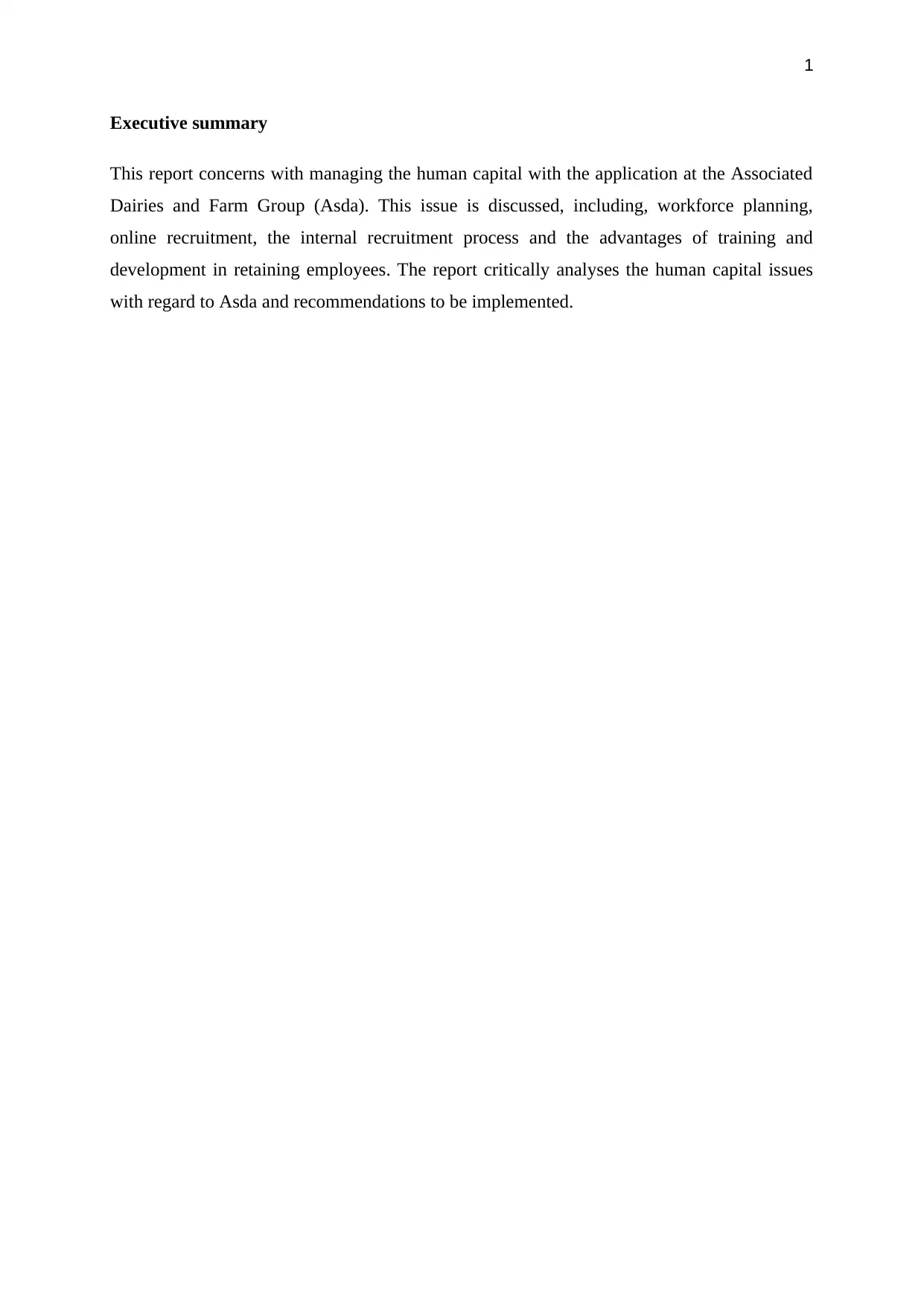
1
Executive summary
This report concerns with managing the human capital with the application at the Associated
Dairies and Farm Group (Asda). This issue is discussed, including, workforce planning,
online recruitment, the internal recruitment process and the advantages of training and
development in retaining employees. The report critically analyses the human capital issues
with regard to Asda and recommendations to be implemented.
Executive summary
This report concerns with managing the human capital with the application at the Associated
Dairies and Farm Group (Asda). This issue is discussed, including, workforce planning,
online recruitment, the internal recruitment process and the advantages of training and
development in retaining employees. The report critically analyses the human capital issues
with regard to Asda and recommendations to be implemented.
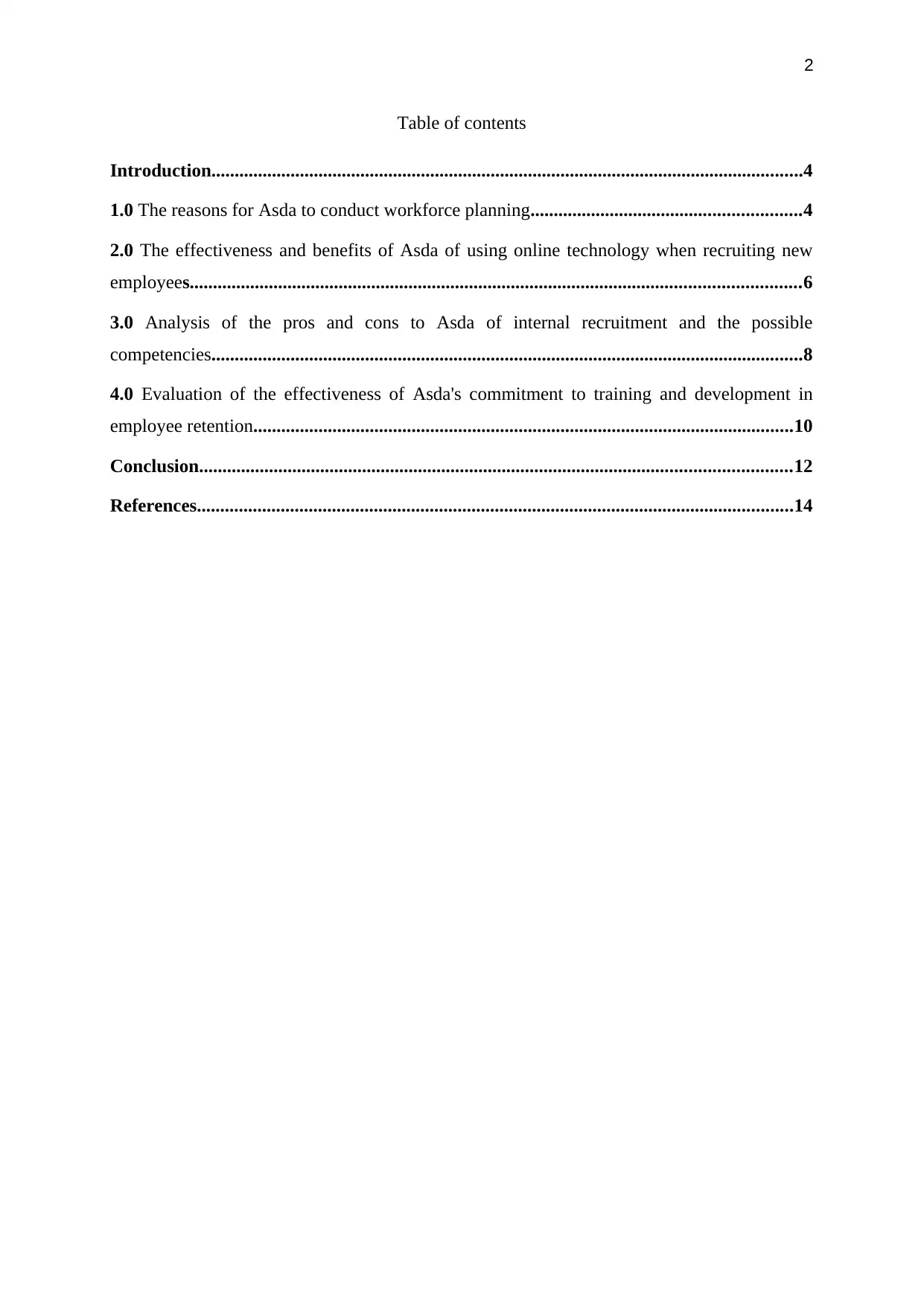
2
Table of contents
Introduction...............................................................................................................................4
1.0 The reasons for Asda to conduct workforce planning..........................................................4
2.0 The effectiveness and benefits of Asda of using online technology when recruiting new
employees...................................................................................................................................6
3.0 Analysis of the pros and cons to Asda of internal recruitment and the possible
competencies...............................................................................................................................8
4.0 Evaluation of the effectiveness of Asda's commitment to training and development in
employee retention....................................................................................................................10
Conclusion...............................................................................................................................12
References................................................................................................................................14
Table of contents
Introduction...............................................................................................................................4
1.0 The reasons for Asda to conduct workforce planning..........................................................4
2.0 The effectiveness and benefits of Asda of using online technology when recruiting new
employees...................................................................................................................................6
3.0 Analysis of the pros and cons to Asda of internal recruitment and the possible
competencies...............................................................................................................................8
4.0 Evaluation of the effectiveness of Asda's commitment to training and development in
employee retention....................................................................................................................10
Conclusion...............................................................................................................................12
References................................................................................................................................14
⊘ This is a preview!⊘
Do you want full access?
Subscribe today to unlock all pages.

Trusted by 1+ million students worldwide
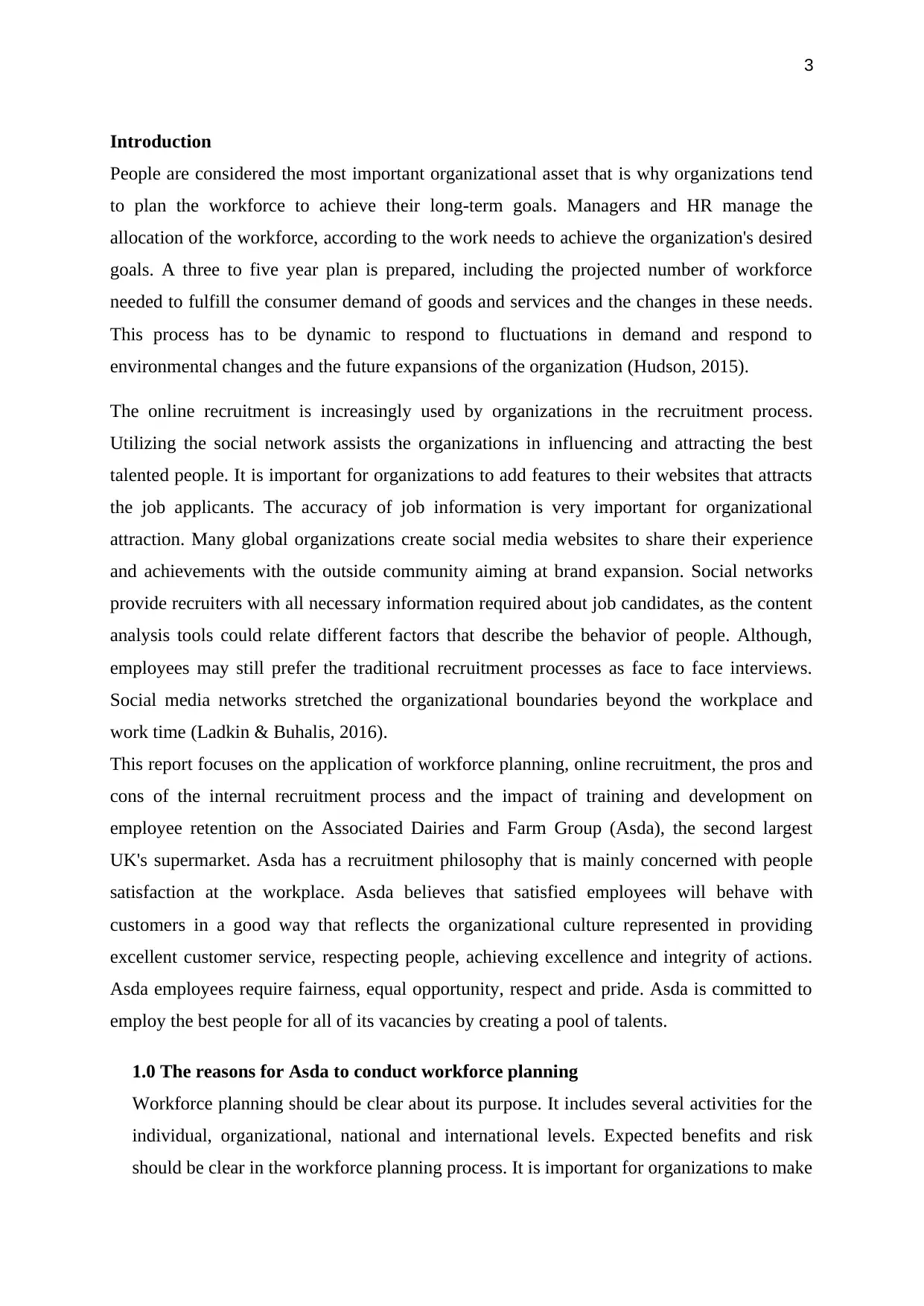
3
Introduction
People are considered the most important organizational asset that is why organizations tend
to plan the workforce to achieve their long-term goals. Managers and HR manage the
allocation of the workforce, according to the work needs to achieve the organization's desired
goals. A three to five year plan is prepared, including the projected number of workforce
needed to fulfill the consumer demand of goods and services and the changes in these needs.
This process has to be dynamic to respond to fluctuations in demand and respond to
environmental changes and the future expansions of the organization (Hudson, 2015).
The online recruitment is increasingly used by organizations in the recruitment process.
Utilizing the social network assists the organizations in influencing and attracting the best
talented people. It is important for organizations to add features to their websites that attracts
the job applicants. The accuracy of job information is very important for organizational
attraction. Many global organizations create social media websites to share their experience
and achievements with the outside community aiming at brand expansion. Social networks
provide recruiters with all necessary information required about job candidates, as the content
analysis tools could relate different factors that describe the behavior of people. Although,
employees may still prefer the traditional recruitment processes as face to face interviews.
Social media networks stretched the organizational boundaries beyond the workplace and
work time (Ladkin & Buhalis, 2016).
This report focuses on the application of workforce planning, online recruitment, the pros and
cons of the internal recruitment process and the impact of training and development on
employee retention on the Associated Dairies and Farm Group (Asda), the second largest
UK's supermarket. Asda has a recruitment philosophy that is mainly concerned with people
satisfaction at the workplace. Asda believes that satisfied employees will behave with
customers in a good way that reflects the organizational culture represented in providing
excellent customer service, respecting people, achieving excellence and integrity of actions.
Asda employees require fairness, equal opportunity, respect and pride. Asda is committed to
employ the best people for all of its vacancies by creating a pool of talents.
1.0 The reasons for Asda to conduct workforce planning
Workforce planning should be clear about its purpose. It includes several activities for the
individual, organizational, national and international levels. Expected benefits and risk
should be clear in the workforce planning process. It is important for organizations to make
Introduction
People are considered the most important organizational asset that is why organizations tend
to plan the workforce to achieve their long-term goals. Managers and HR manage the
allocation of the workforce, according to the work needs to achieve the organization's desired
goals. A three to five year plan is prepared, including the projected number of workforce
needed to fulfill the consumer demand of goods and services and the changes in these needs.
This process has to be dynamic to respond to fluctuations in demand and respond to
environmental changes and the future expansions of the organization (Hudson, 2015).
The online recruitment is increasingly used by organizations in the recruitment process.
Utilizing the social network assists the organizations in influencing and attracting the best
talented people. It is important for organizations to add features to their websites that attracts
the job applicants. The accuracy of job information is very important for organizational
attraction. Many global organizations create social media websites to share their experience
and achievements with the outside community aiming at brand expansion. Social networks
provide recruiters with all necessary information required about job candidates, as the content
analysis tools could relate different factors that describe the behavior of people. Although,
employees may still prefer the traditional recruitment processes as face to face interviews.
Social media networks stretched the organizational boundaries beyond the workplace and
work time (Ladkin & Buhalis, 2016).
This report focuses on the application of workforce planning, online recruitment, the pros and
cons of the internal recruitment process and the impact of training and development on
employee retention on the Associated Dairies and Farm Group (Asda), the second largest
UK's supermarket. Asda has a recruitment philosophy that is mainly concerned with people
satisfaction at the workplace. Asda believes that satisfied employees will behave with
customers in a good way that reflects the organizational culture represented in providing
excellent customer service, respecting people, achieving excellence and integrity of actions.
Asda employees require fairness, equal opportunity, respect and pride. Asda is committed to
employ the best people for all of its vacancies by creating a pool of talents.
1.0 The reasons for Asda to conduct workforce planning
Workforce planning should be clear about its purpose. It includes several activities for the
individual, organizational, national and international levels. Expected benefits and risk
should be clear in the workforce planning process. It is important for organizations to make
Paraphrase This Document
Need a fresh take? Get an instant paraphrase of this document with our AI Paraphraser
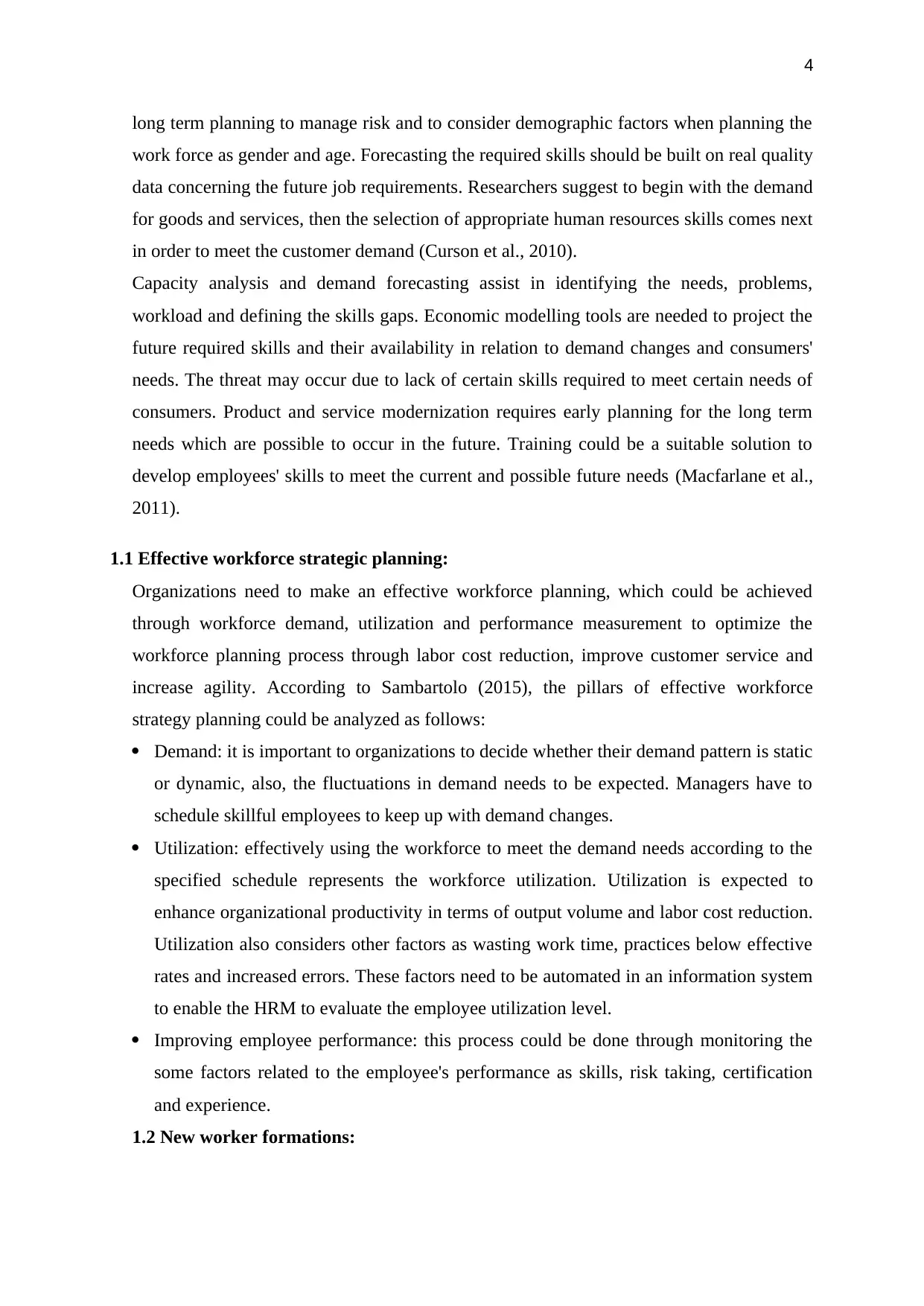
4
long term planning to manage risk and to consider demographic factors when planning the
work force as gender and age. Forecasting the required skills should be built on real quality
data concerning the future job requirements. Researchers suggest to begin with the demand
for goods and services, then the selection of appropriate human resources skills comes next
in order to meet the customer demand (Curson et al., 2010).
Capacity analysis and demand forecasting assist in identifying the needs, problems,
workload and defining the skills gaps. Economic modelling tools are needed to project the
future required skills and their availability in relation to demand changes and consumers'
needs. The threat may occur due to lack of certain skills required to meet certain needs of
consumers. Product and service modernization requires early planning for the long term
needs which are possible to occur in the future. Training could be a suitable solution to
develop employees' skills to meet the current and possible future needs (Macfarlane et al.,
2011).
1.1 Effective workforce strategic planning:
Organizations need to make an effective workforce planning, which could be achieved
through workforce demand, utilization and performance measurement to optimize the
workforce planning process through labor cost reduction, improve customer service and
increase agility. According to Sambartolo (2015), the pillars of effective workforce
strategy planning could be analyzed as follows:
Demand: it is important to organizations to decide whether their demand pattern is static
or dynamic, also, the fluctuations in demand needs to be expected. Managers have to
schedule skillful employees to keep up with demand changes.
Utilization: effectively using the workforce to meet the demand needs according to the
specified schedule represents the workforce utilization. Utilization is expected to
enhance organizational productivity in terms of output volume and labor cost reduction.
Utilization also considers other factors as wasting work time, practices below effective
rates and increased errors. These factors need to be automated in an information system
to enable the HRM to evaluate the employee utilization level.
Improving employee performance: this process could be done through monitoring the
some factors related to the employee's performance as skills, risk taking, certification
and experience.
1.2 New worker formations:
long term planning to manage risk and to consider demographic factors when planning the
work force as gender and age. Forecasting the required skills should be built on real quality
data concerning the future job requirements. Researchers suggest to begin with the demand
for goods and services, then the selection of appropriate human resources skills comes next
in order to meet the customer demand (Curson et al., 2010).
Capacity analysis and demand forecasting assist in identifying the needs, problems,
workload and defining the skills gaps. Economic modelling tools are needed to project the
future required skills and their availability in relation to demand changes and consumers'
needs. The threat may occur due to lack of certain skills required to meet certain needs of
consumers. Product and service modernization requires early planning for the long term
needs which are possible to occur in the future. Training could be a suitable solution to
develop employees' skills to meet the current and possible future needs (Macfarlane et al.,
2011).
1.1 Effective workforce strategic planning:
Organizations need to make an effective workforce planning, which could be achieved
through workforce demand, utilization and performance measurement to optimize the
workforce planning process through labor cost reduction, improve customer service and
increase agility. According to Sambartolo (2015), the pillars of effective workforce
strategy planning could be analyzed as follows:
Demand: it is important to organizations to decide whether their demand pattern is static
or dynamic, also, the fluctuations in demand needs to be expected. Managers have to
schedule skillful employees to keep up with demand changes.
Utilization: effectively using the workforce to meet the demand needs according to the
specified schedule represents the workforce utilization. Utilization is expected to
enhance organizational productivity in terms of output volume and labor cost reduction.
Utilization also considers other factors as wasting work time, practices below effective
rates and increased errors. These factors need to be automated in an information system
to enable the HRM to evaluate the employee utilization level.
Improving employee performance: this process could be done through monitoring the
some factors related to the employee's performance as skills, risk taking, certification
and experience.
1.2 New worker formations:
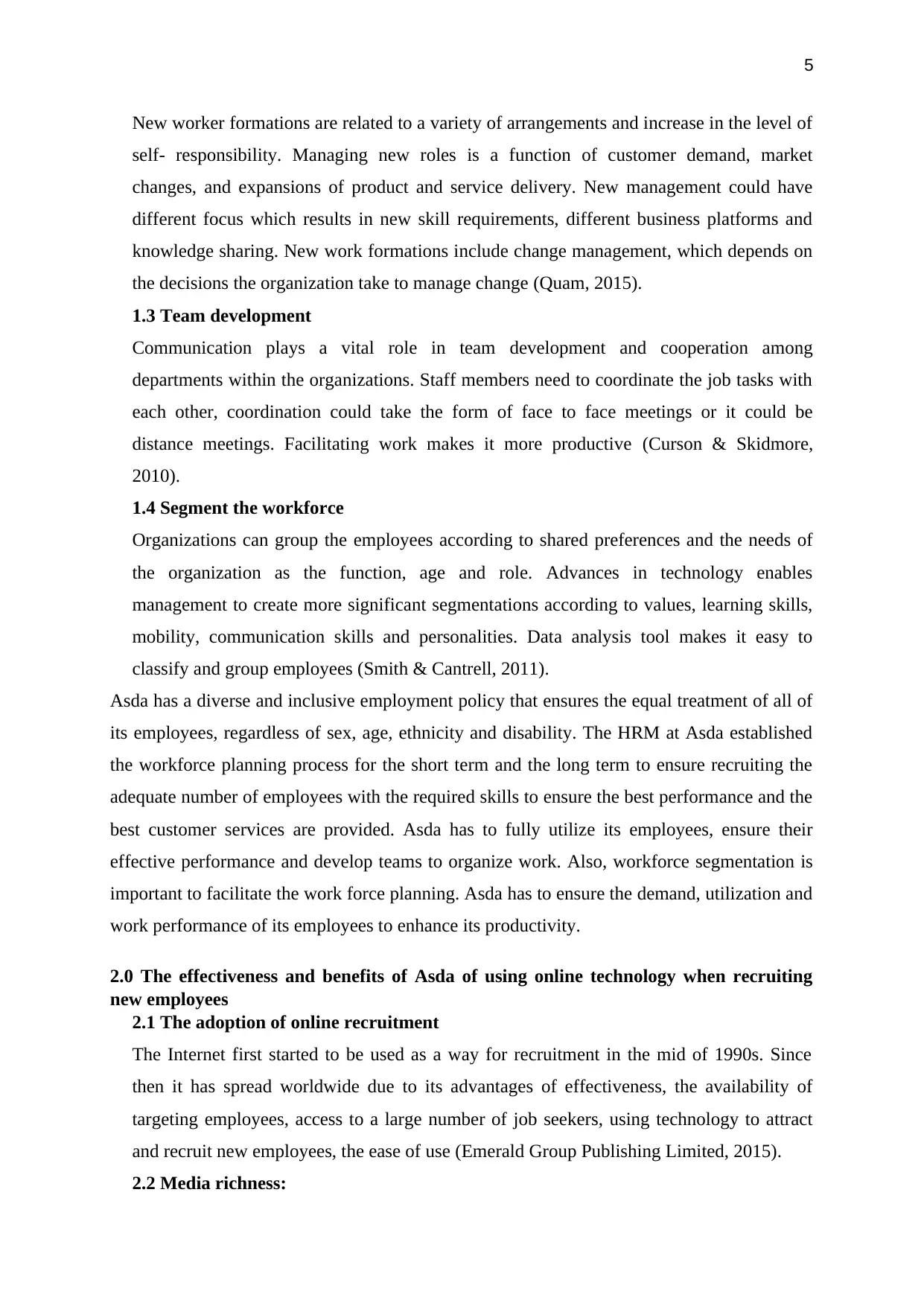
5
New worker formations are related to a variety of arrangements and increase in the level of
self- responsibility. Managing new roles is a function of customer demand, market
changes, and expansions of product and service delivery. New management could have
different focus which results in new skill requirements, different business platforms and
knowledge sharing. New work formations include change management, which depends on
the decisions the organization take to manage change (Quam, 2015).
1.3 Team development
Communication plays a vital role in team development and cooperation among
departments within the organizations. Staff members need to coordinate the job tasks with
each other, coordination could take the form of face to face meetings or it could be
distance meetings. Facilitating work makes it more productive (Curson & Skidmore,
2010).
1.4 Segment the workforce
Organizations can group the employees according to shared preferences and the needs of
the organization as the function, age and role. Advances in technology enables
management to create more significant segmentations according to values, learning skills,
mobility, communication skills and personalities. Data analysis tool makes it easy to
classify and group employees (Smith & Cantrell, 2011).
Asda has a diverse and inclusive employment policy that ensures the equal treatment of all of
its employees, regardless of sex, age, ethnicity and disability. The HRM at Asda established
the workforce planning process for the short term and the long term to ensure recruiting the
adequate number of employees with the required skills to ensure the best performance and the
best customer services are provided. Asda has to fully utilize its employees, ensure their
effective performance and develop teams to organize work. Also, workforce segmentation is
important to facilitate the work force planning. Asda has to ensure the demand, utilization and
work performance of its employees to enhance its productivity.
2.0 The effectiveness and benefits of Asda of using online technology when recruiting
new employees
2.1 The adoption of online recruitment
The Internet first started to be used as a way for recruitment in the mid of 1990s. Since
then it has spread worldwide due to its advantages of effectiveness, the availability of
targeting employees, access to a large number of job seekers, using technology to attract
and recruit new employees, the ease of use (Emerald Group Publishing Limited, 2015).
2.2 Media richness:
New worker formations are related to a variety of arrangements and increase in the level of
self- responsibility. Managing new roles is a function of customer demand, market
changes, and expansions of product and service delivery. New management could have
different focus which results in new skill requirements, different business platforms and
knowledge sharing. New work formations include change management, which depends on
the decisions the organization take to manage change (Quam, 2015).
1.3 Team development
Communication plays a vital role in team development and cooperation among
departments within the organizations. Staff members need to coordinate the job tasks with
each other, coordination could take the form of face to face meetings or it could be
distance meetings. Facilitating work makes it more productive (Curson & Skidmore,
2010).
1.4 Segment the workforce
Organizations can group the employees according to shared preferences and the needs of
the organization as the function, age and role. Advances in technology enables
management to create more significant segmentations according to values, learning skills,
mobility, communication skills and personalities. Data analysis tool makes it easy to
classify and group employees (Smith & Cantrell, 2011).
Asda has a diverse and inclusive employment policy that ensures the equal treatment of all of
its employees, regardless of sex, age, ethnicity and disability. The HRM at Asda established
the workforce planning process for the short term and the long term to ensure recruiting the
adequate number of employees with the required skills to ensure the best performance and the
best customer services are provided. Asda has to fully utilize its employees, ensure their
effective performance and develop teams to organize work. Also, workforce segmentation is
important to facilitate the work force planning. Asda has to ensure the demand, utilization and
work performance of its employees to enhance its productivity.
2.0 The effectiveness and benefits of Asda of using online technology when recruiting
new employees
2.1 The adoption of online recruitment
The Internet first started to be used as a way for recruitment in the mid of 1990s. Since
then it has spread worldwide due to its advantages of effectiveness, the availability of
targeting employees, access to a large number of job seekers, using technology to attract
and recruit new employees, the ease of use (Emerald Group Publishing Limited, 2015).
2.2 Media richness:
⊘ This is a preview!⊘
Do you want full access?
Subscribe today to unlock all pages.

Trusted by 1+ million students worldwide
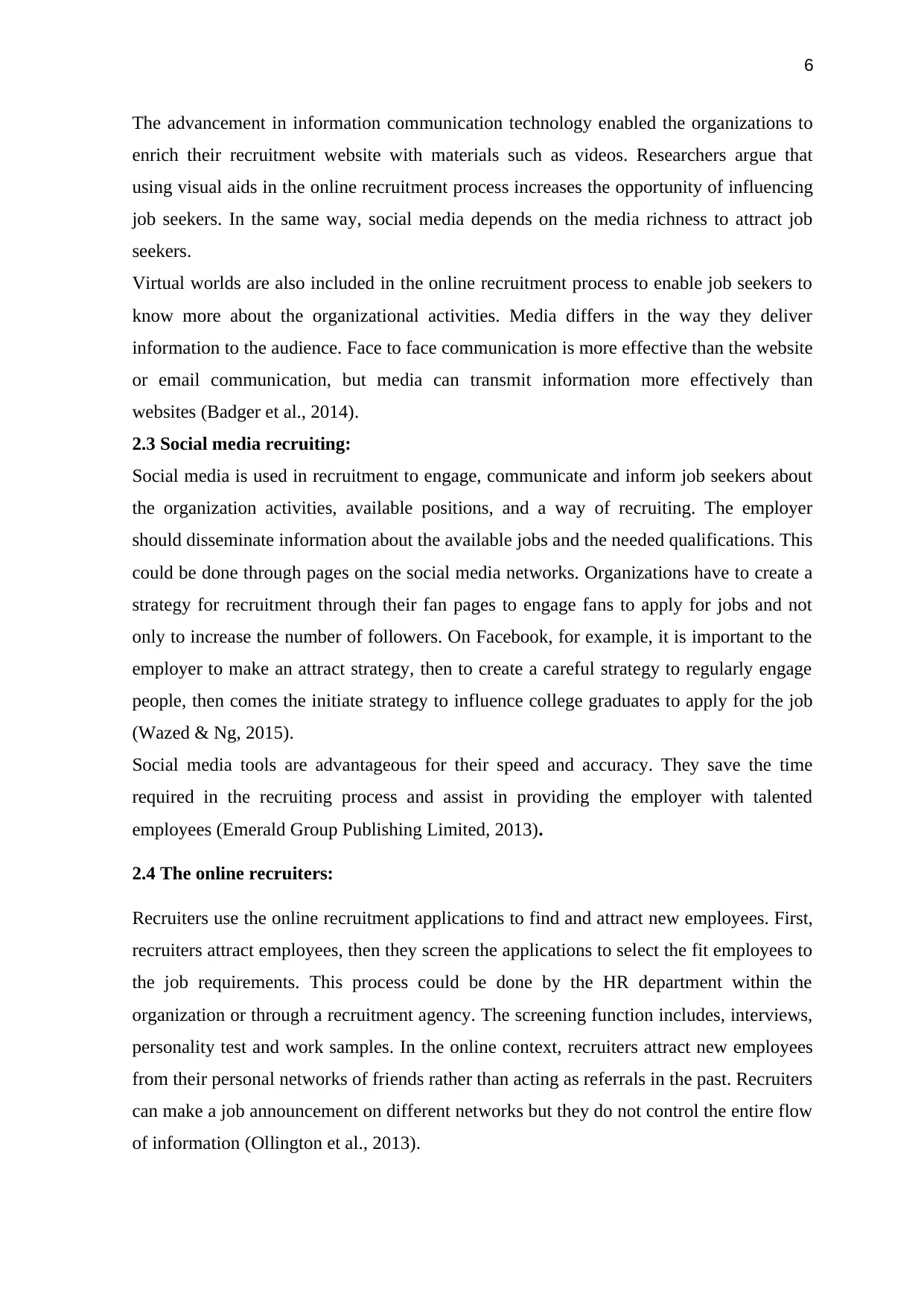
6
The advancement in information communication technology enabled the organizations to
enrich their recruitment website with materials such as videos. Researchers argue that
using visual aids in the online recruitment process increases the opportunity of influencing
job seekers. In the same way, social media depends on the media richness to attract job
seekers.
Virtual worlds are also included in the online recruitment process to enable job seekers to
know more about the organizational activities. Media differs in the way they deliver
information to the audience. Face to face communication is more effective than the website
or email communication, but media can transmit information more effectively than
websites (Badger et al., 2014).
2.3 Social media recruiting:
Social media is used in recruitment to engage, communicate and inform job seekers about
the organization activities, available positions, and a way of recruiting. The employer
should disseminate information about the available jobs and the needed qualifications. This
could be done through pages on the social media networks. Organizations have to create a
strategy for recruitment through their fan pages to engage fans to apply for jobs and not
only to increase the number of followers. On Facebook, for example, it is important to the
employer to make an attract strategy, then to create a careful strategy to regularly engage
people, then comes the initiate strategy to influence college graduates to apply for the job
(Wazed & Ng, 2015).
Social media tools are advantageous for their speed and accuracy. They save the time
required in the recruiting process and assist in providing the employer with talented
employees (Emerald Group Publishing Limited, 2013).
2.4 The online recruiters:
Recruiters use the online recruitment applications to find and attract new employees. First,
recruiters attract employees, then they screen the applications to select the fit employees to
the job requirements. This process could be done by the HR department within the
organization or through a recruitment agency. The screening function includes, interviews,
personality test and work samples. In the online context, recruiters attract new employees
from their personal networks of friends rather than acting as referrals in the past. Recruiters
can make a job announcement on different networks but they do not control the entire flow
of information (Ollington et al., 2013).
The advancement in information communication technology enabled the organizations to
enrich their recruitment website with materials such as videos. Researchers argue that
using visual aids in the online recruitment process increases the opportunity of influencing
job seekers. In the same way, social media depends on the media richness to attract job
seekers.
Virtual worlds are also included in the online recruitment process to enable job seekers to
know more about the organizational activities. Media differs in the way they deliver
information to the audience. Face to face communication is more effective than the website
or email communication, but media can transmit information more effectively than
websites (Badger et al., 2014).
2.3 Social media recruiting:
Social media is used in recruitment to engage, communicate and inform job seekers about
the organization activities, available positions, and a way of recruiting. The employer
should disseminate information about the available jobs and the needed qualifications. This
could be done through pages on the social media networks. Organizations have to create a
strategy for recruitment through their fan pages to engage fans to apply for jobs and not
only to increase the number of followers. On Facebook, for example, it is important to the
employer to make an attract strategy, then to create a careful strategy to regularly engage
people, then comes the initiate strategy to influence college graduates to apply for the job
(Wazed & Ng, 2015).
Social media tools are advantageous for their speed and accuracy. They save the time
required in the recruiting process and assist in providing the employer with talented
employees (Emerald Group Publishing Limited, 2013).
2.4 The online recruiters:
Recruiters use the online recruitment applications to find and attract new employees. First,
recruiters attract employees, then they screen the applications to select the fit employees to
the job requirements. This process could be done by the HR department within the
organization or through a recruitment agency. The screening function includes, interviews,
personality test and work samples. In the online context, recruiters attract new employees
from their personal networks of friends rather than acting as referrals in the past. Recruiters
can make a job announcement on different networks but they do not control the entire flow
of information (Ollington et al., 2013).
Paraphrase This Document
Need a fresh take? Get an instant paraphrase of this document with our AI Paraphraser
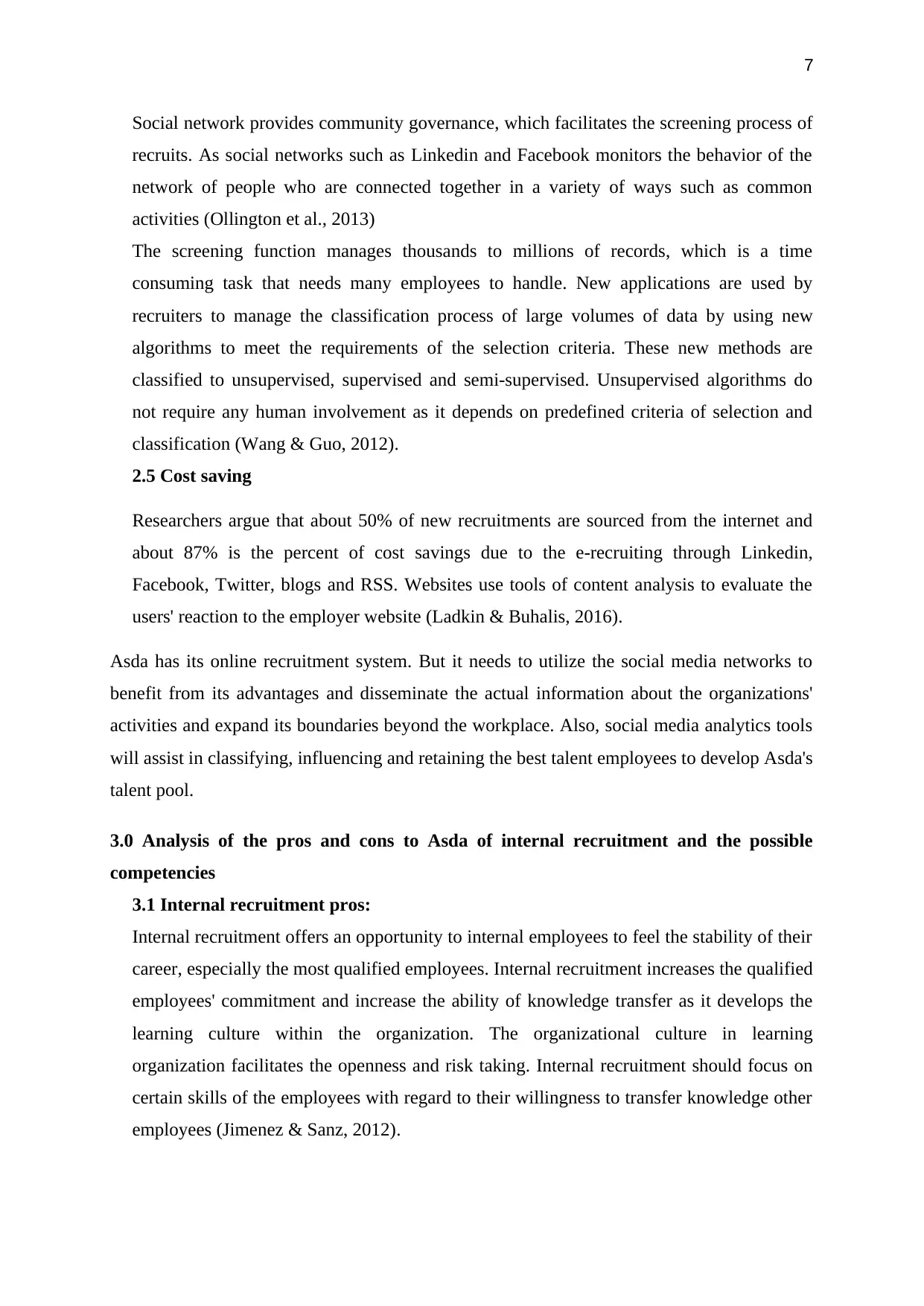
7
Social network provides community governance, which facilitates the screening process of
recruits. As social networks such as Linkedin and Facebook monitors the behavior of the
network of people who are connected together in a variety of ways such as common
activities (Ollington et al., 2013)
The screening function manages thousands to millions of records, which is a time
consuming task that needs many employees to handle. New applications are used by
recruiters to manage the classification process of large volumes of data by using new
algorithms to meet the requirements of the selection criteria. These new methods are
classified to unsupervised, supervised and semi-supervised. Unsupervised algorithms do
not require any human involvement as it depends on predefined criteria of selection and
classification (Wang & Guo, 2012).
2.5 Cost saving
Researchers argue that about 50% of new recruitments are sourced from the internet and
about 87% is the percent of cost savings due to the e-recruiting through Linkedin,
Facebook, Twitter, blogs and RSS. Websites use tools of content analysis to evaluate the
users' reaction to the employer website (Ladkin & Buhalis, 2016).
Asda has its online recruitment system. But it needs to utilize the social media networks to
benefit from its advantages and disseminate the actual information about the organizations'
activities and expand its boundaries beyond the workplace. Also, social media analytics tools
will assist in classifying, influencing and retaining the best talent employees to develop Asda's
talent pool.
3.0 Analysis of the pros and cons to Asda of internal recruitment and the possible
competencies
3.1 Internal recruitment pros:
Internal recruitment offers an opportunity to internal employees to feel the stability of their
career, especially the most qualified employees. Internal recruitment increases the qualified
employees' commitment and increase the ability of knowledge transfer as it develops the
learning culture within the organization. The organizational culture in learning
organization facilitates the openness and risk taking. Internal recruitment should focus on
certain skills of the employees with regard to their willingness to transfer knowledge other
employees (Jimenez & Sanz, 2012).
Social network provides community governance, which facilitates the screening process of
recruits. As social networks such as Linkedin and Facebook monitors the behavior of the
network of people who are connected together in a variety of ways such as common
activities (Ollington et al., 2013)
The screening function manages thousands to millions of records, which is a time
consuming task that needs many employees to handle. New applications are used by
recruiters to manage the classification process of large volumes of data by using new
algorithms to meet the requirements of the selection criteria. These new methods are
classified to unsupervised, supervised and semi-supervised. Unsupervised algorithms do
not require any human involvement as it depends on predefined criteria of selection and
classification (Wang & Guo, 2012).
2.5 Cost saving
Researchers argue that about 50% of new recruitments are sourced from the internet and
about 87% is the percent of cost savings due to the e-recruiting through Linkedin,
Facebook, Twitter, blogs and RSS. Websites use tools of content analysis to evaluate the
users' reaction to the employer website (Ladkin & Buhalis, 2016).
Asda has its online recruitment system. But it needs to utilize the social media networks to
benefit from its advantages and disseminate the actual information about the organizations'
activities and expand its boundaries beyond the workplace. Also, social media analytics tools
will assist in classifying, influencing and retaining the best talent employees to develop Asda's
talent pool.
3.0 Analysis of the pros and cons to Asda of internal recruitment and the possible
competencies
3.1 Internal recruitment pros:
Internal recruitment offers an opportunity to internal employees to feel the stability of their
career, especially the most qualified employees. Internal recruitment increases the qualified
employees' commitment and increase the ability of knowledge transfer as it develops the
learning culture within the organization. The organizational culture in learning
organization facilitates the openness and risk taking. Internal recruitment should focus on
certain skills of the employees with regard to their willingness to transfer knowledge other
employees (Jimenez & Sanz, 2012).
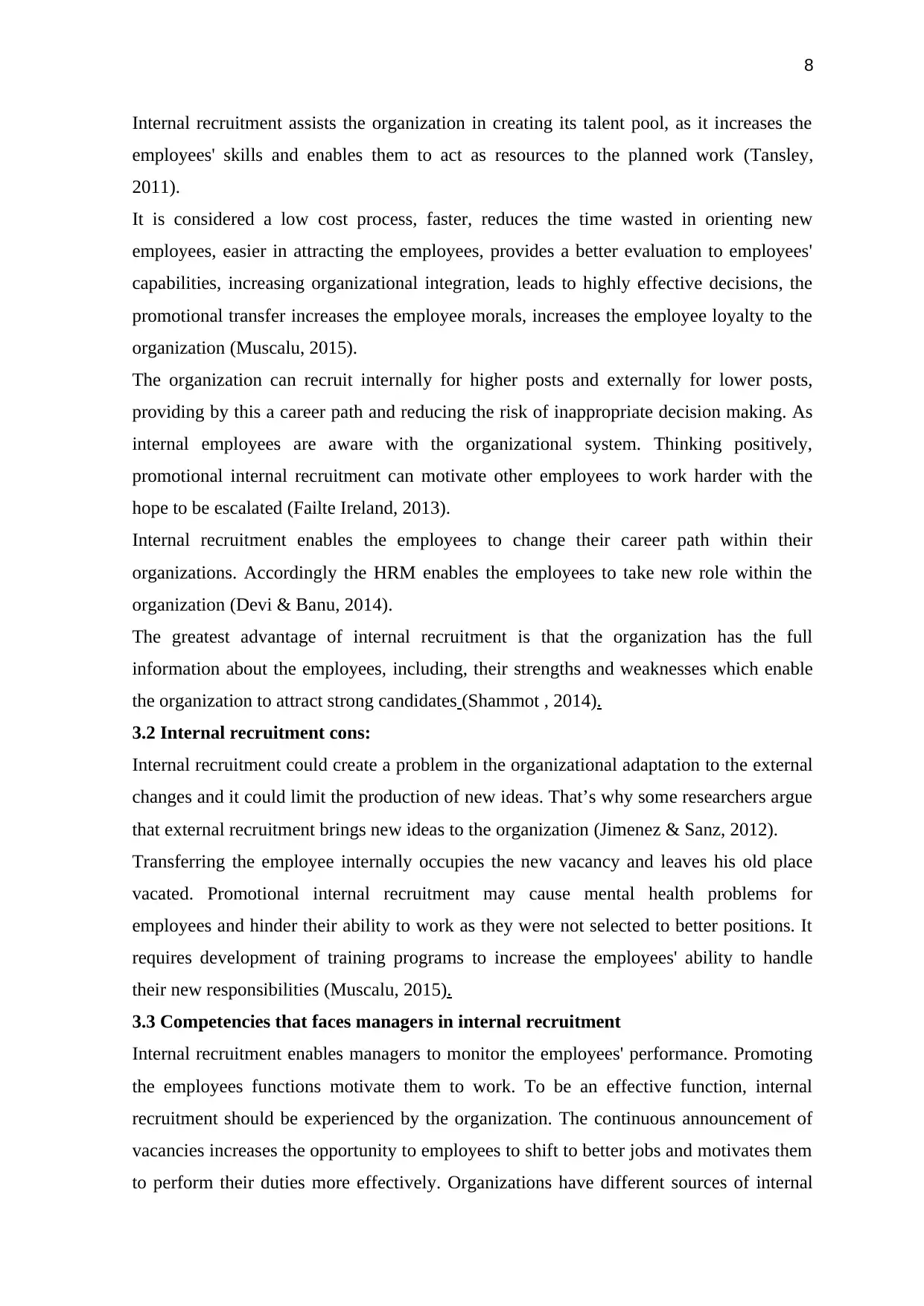
8
Internal recruitment assists the organization in creating its talent pool, as it increases the
employees' skills and enables them to act as resources to the planned work (Tansley,
2011).
It is considered a low cost process, faster, reduces the time wasted in orienting new
employees, easier in attracting the employees, provides a better evaluation to employees'
capabilities, increasing organizational integration, leads to highly effective decisions, the
promotional transfer increases the employee morals, increases the employee loyalty to the
organization (Muscalu, 2015).
The organization can recruit internally for higher posts and externally for lower posts,
providing by this a career path and reducing the risk of inappropriate decision making. As
internal employees are aware with the organizational system. Thinking positively,
promotional internal recruitment can motivate other employees to work harder with the
hope to be escalated (Failte Ireland, 2013).
Internal recruitment enables the employees to change their career path within their
organizations. Accordingly the HRM enables the employees to take new role within the
organization (Devi & Banu, 2014).
The greatest advantage of internal recruitment is that the organization has the full
information about the employees, including, their strengths and weaknesses which enable
the organization to attract strong candidates (Shammot , 2014).
3.2 Internal recruitment cons:
Internal recruitment could create a problem in the organizational adaptation to the external
changes and it could limit the production of new ideas. That’s why some researchers argue
that external recruitment brings new ideas to the organization (Jimenez & Sanz, 2012).
Transferring the employee internally occupies the new vacancy and leaves his old place
vacated. Promotional internal recruitment may cause mental health problems for
employees and hinder their ability to work as they were not selected to better positions. It
requires development of training programs to increase the employees' ability to handle
their new responsibilities (Muscalu, 2015).
3.3 Competencies that faces managers in internal recruitment
Internal recruitment enables managers to monitor the employees' performance. Promoting
the employees functions motivate them to work. To be an effective function, internal
recruitment should be experienced by the organization. The continuous announcement of
vacancies increases the opportunity to employees to shift to better jobs and motivates them
to perform their duties more effectively. Organizations have different sources of internal
Internal recruitment assists the organization in creating its talent pool, as it increases the
employees' skills and enables them to act as resources to the planned work (Tansley,
2011).
It is considered a low cost process, faster, reduces the time wasted in orienting new
employees, easier in attracting the employees, provides a better evaluation to employees'
capabilities, increasing organizational integration, leads to highly effective decisions, the
promotional transfer increases the employee morals, increases the employee loyalty to the
organization (Muscalu, 2015).
The organization can recruit internally for higher posts and externally for lower posts,
providing by this a career path and reducing the risk of inappropriate decision making. As
internal employees are aware with the organizational system. Thinking positively,
promotional internal recruitment can motivate other employees to work harder with the
hope to be escalated (Failte Ireland, 2013).
Internal recruitment enables the employees to change their career path within their
organizations. Accordingly the HRM enables the employees to take new role within the
organization (Devi & Banu, 2014).
The greatest advantage of internal recruitment is that the organization has the full
information about the employees, including, their strengths and weaknesses which enable
the organization to attract strong candidates (Shammot , 2014).
3.2 Internal recruitment cons:
Internal recruitment could create a problem in the organizational adaptation to the external
changes and it could limit the production of new ideas. That’s why some researchers argue
that external recruitment brings new ideas to the organization (Jimenez & Sanz, 2012).
Transferring the employee internally occupies the new vacancy and leaves his old place
vacated. Promotional internal recruitment may cause mental health problems for
employees and hinder their ability to work as they were not selected to better positions. It
requires development of training programs to increase the employees' ability to handle
their new responsibilities (Muscalu, 2015).
3.3 Competencies that faces managers in internal recruitment
Internal recruitment enables managers to monitor the employees' performance. Promoting
the employees functions motivate them to work. To be an effective function, internal
recruitment should be experienced by the organization. The continuous announcement of
vacancies increases the opportunity to employees to shift to better jobs and motivates them
to perform their duties more effectively. Organizations have different sources of internal
⊘ This is a preview!⊘
Do you want full access?
Subscribe today to unlock all pages.

Trusted by 1+ million students worldwide
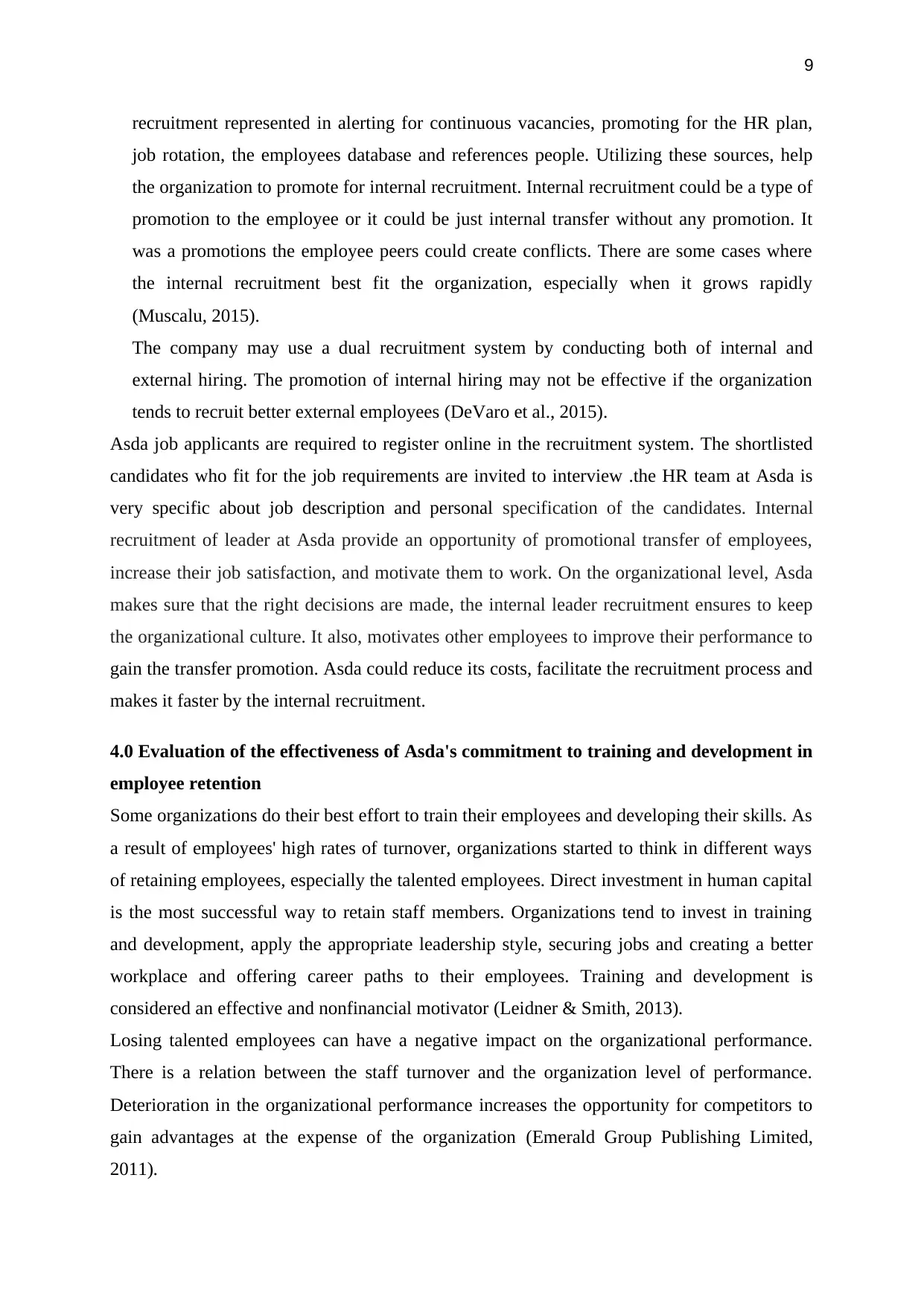
9
recruitment represented in alerting for continuous vacancies, promoting for the HR plan,
job rotation, the employees database and references people. Utilizing these sources, help
the organization to promote for internal recruitment. Internal recruitment could be a type of
promotion to the employee or it could be just internal transfer without any promotion. It
was a promotions the employee peers could create conflicts. There are some cases where
the internal recruitment best fit the organization, especially when it grows rapidly
(Muscalu, 2015).
The company may use a dual recruitment system by conducting both of internal and
external hiring. The promotion of internal hiring may not be effective if the organization
tends to recruit better external employees (DeVaro et al., 2015).
Asda job applicants are required to register online in the recruitment system. The shortlisted
candidates who fit for the job requirements are invited to interview .the HR team at Asda is
very specific about job description and personal specification of the candidates. Internal
recruitment of leader at Asda provide an opportunity of promotional transfer of employees,
increase their job satisfaction, and motivate them to work. On the organizational level, Asda
makes sure that the right decisions are made, the internal leader recruitment ensures to keep
the organizational culture. It also, motivates other employees to improve their performance to
gain the transfer promotion. Asda could reduce its costs, facilitate the recruitment process and
makes it faster by the internal recruitment.
4.0 Evaluation of the effectiveness of Asda's commitment to training and development in
employee retention
Some organizations do their best effort to train their employees and developing their skills. As
a result of employees' high rates of turnover, organizations started to think in different ways
of retaining employees, especially the talented employees. Direct investment in human capital
is the most successful way to retain staff members. Organizations tend to invest in training
and development, apply the appropriate leadership style, securing jobs and creating a better
workplace and offering career paths to their employees. Training and development is
considered an effective and nonfinancial motivator (Leidner & Smith, 2013).
Losing talented employees can have a negative impact on the organizational performance.
There is a relation between the staff turnover and the organization level of performance.
Deterioration in the organizational performance increases the opportunity for competitors to
gain advantages at the expense of the organization (Emerald Group Publishing Limited,
2011).
recruitment represented in alerting for continuous vacancies, promoting for the HR plan,
job rotation, the employees database and references people. Utilizing these sources, help
the organization to promote for internal recruitment. Internal recruitment could be a type of
promotion to the employee or it could be just internal transfer without any promotion. It
was a promotions the employee peers could create conflicts. There are some cases where
the internal recruitment best fit the organization, especially when it grows rapidly
(Muscalu, 2015).
The company may use a dual recruitment system by conducting both of internal and
external hiring. The promotion of internal hiring may not be effective if the organization
tends to recruit better external employees (DeVaro et al., 2015).
Asda job applicants are required to register online in the recruitment system. The shortlisted
candidates who fit for the job requirements are invited to interview .the HR team at Asda is
very specific about job description and personal specification of the candidates. Internal
recruitment of leader at Asda provide an opportunity of promotional transfer of employees,
increase their job satisfaction, and motivate them to work. On the organizational level, Asda
makes sure that the right decisions are made, the internal leader recruitment ensures to keep
the organizational culture. It also, motivates other employees to improve their performance to
gain the transfer promotion. Asda could reduce its costs, facilitate the recruitment process and
makes it faster by the internal recruitment.
4.0 Evaluation of the effectiveness of Asda's commitment to training and development in
employee retention
Some organizations do their best effort to train their employees and developing their skills. As
a result of employees' high rates of turnover, organizations started to think in different ways
of retaining employees, especially the talented employees. Direct investment in human capital
is the most successful way to retain staff members. Organizations tend to invest in training
and development, apply the appropriate leadership style, securing jobs and creating a better
workplace and offering career paths to their employees. Training and development is
considered an effective and nonfinancial motivator (Leidner & Smith, 2013).
Losing talented employees can have a negative impact on the organizational performance.
There is a relation between the staff turnover and the organization level of performance.
Deterioration in the organizational performance increases the opportunity for competitors to
gain advantages at the expense of the organization (Emerald Group Publishing Limited,
2011).
Paraphrase This Document
Need a fresh take? Get an instant paraphrase of this document with our AI Paraphraser
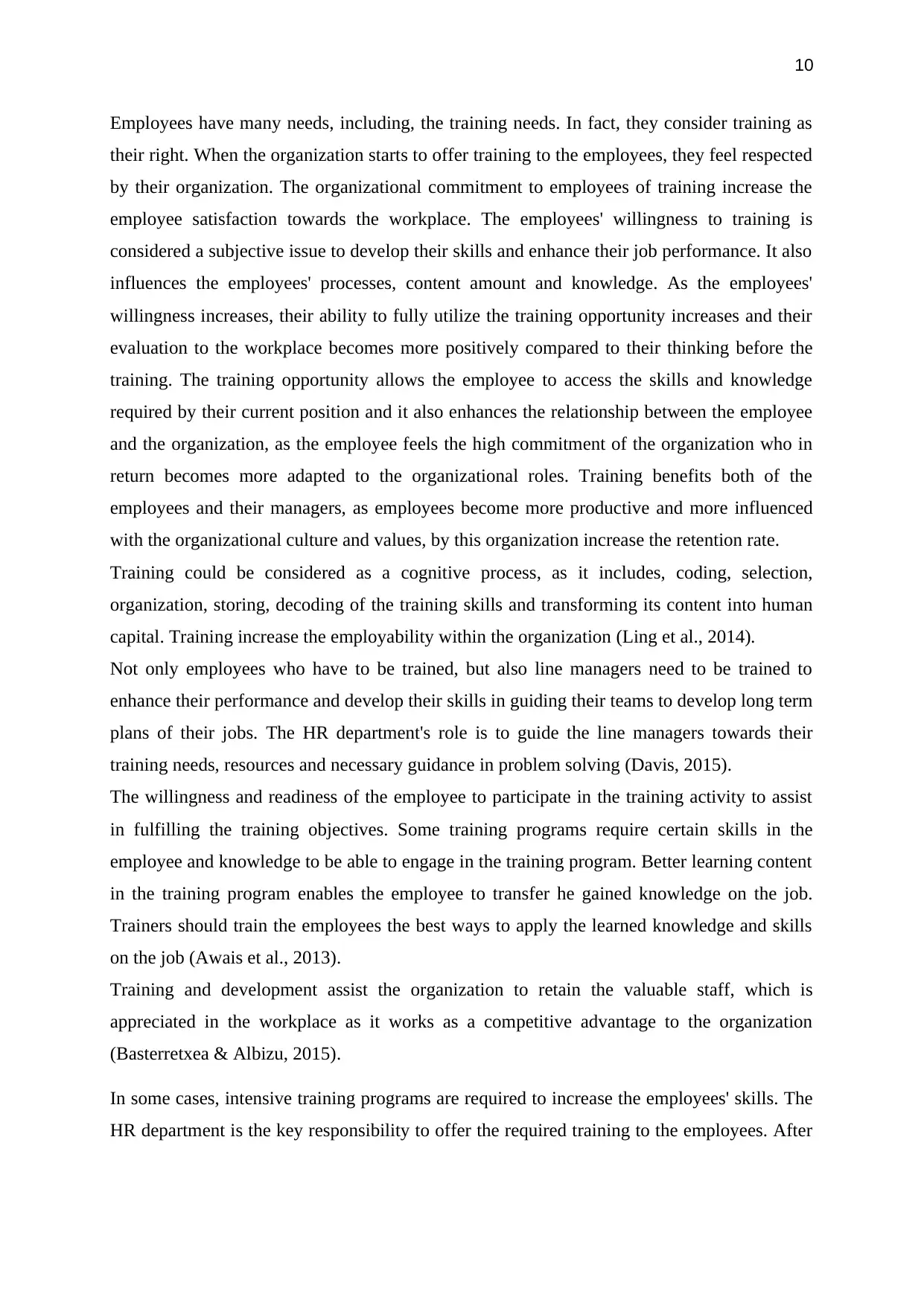
10
Employees have many needs, including, the training needs. In fact, they consider training as
their right. When the organization starts to offer training to the employees, they feel respected
by their organization. The organizational commitment to employees of training increase the
employee satisfaction towards the workplace. The employees' willingness to training is
considered a subjective issue to develop their skills and enhance their job performance. It also
influences the employees' processes, content amount and knowledge. As the employees'
willingness increases, their ability to fully utilize the training opportunity increases and their
evaluation to the workplace becomes more positively compared to their thinking before the
training. The training opportunity allows the employee to access the skills and knowledge
required by their current position and it also enhances the relationship between the employee
and the organization, as the employee feels the high commitment of the organization who in
return becomes more adapted to the organizational roles. Training benefits both of the
employees and their managers, as employees become more productive and more influenced
with the organizational culture and values, by this organization increase the retention rate.
Training could be considered as a cognitive process, as it includes, coding, selection,
organization, storing, decoding of the training skills and transforming its content into human
capital. Training increase the employability within the organization (Ling et al., 2014).
Not only employees who have to be trained, but also line managers need to be trained to
enhance their performance and develop their skills in guiding their teams to develop long term
plans of their jobs. The HR department's role is to guide the line managers towards their
training needs, resources and necessary guidance in problem solving (Davis, 2015).
The willingness and readiness of the employee to participate in the training activity to assist
in fulfilling the training objectives. Some training programs require certain skills in the
employee and knowledge to be able to engage in the training program. Better learning content
in the training program enables the employee to transfer he gained knowledge on the job.
Trainers should train the employees the best ways to apply the learned knowledge and skills
on the job (Awais et al., 2013).
Training and development assist the organization to retain the valuable staff, which is
appreciated in the workplace as it works as a competitive advantage to the organization
(Basterretxea & Albizu, 2015).
In some cases, intensive training programs are required to increase the employees' skills. The
HR department is the key responsibility to offer the required training to the employees. After
Employees have many needs, including, the training needs. In fact, they consider training as
their right. When the organization starts to offer training to the employees, they feel respected
by their organization. The organizational commitment to employees of training increase the
employee satisfaction towards the workplace. The employees' willingness to training is
considered a subjective issue to develop their skills and enhance their job performance. It also
influences the employees' processes, content amount and knowledge. As the employees'
willingness increases, their ability to fully utilize the training opportunity increases and their
evaluation to the workplace becomes more positively compared to their thinking before the
training. The training opportunity allows the employee to access the skills and knowledge
required by their current position and it also enhances the relationship between the employee
and the organization, as the employee feels the high commitment of the organization who in
return becomes more adapted to the organizational roles. Training benefits both of the
employees and their managers, as employees become more productive and more influenced
with the organizational culture and values, by this organization increase the retention rate.
Training could be considered as a cognitive process, as it includes, coding, selection,
organization, storing, decoding of the training skills and transforming its content into human
capital. Training increase the employability within the organization (Ling et al., 2014).
Not only employees who have to be trained, but also line managers need to be trained to
enhance their performance and develop their skills in guiding their teams to develop long term
plans of their jobs. The HR department's role is to guide the line managers towards their
training needs, resources and necessary guidance in problem solving (Davis, 2015).
The willingness and readiness of the employee to participate in the training activity to assist
in fulfilling the training objectives. Some training programs require certain skills in the
employee and knowledge to be able to engage in the training program. Better learning content
in the training program enables the employee to transfer he gained knowledge on the job.
Trainers should train the employees the best ways to apply the learned knowledge and skills
on the job (Awais et al., 2013).
Training and development assist the organization to retain the valuable staff, which is
appreciated in the workplace as it works as a competitive advantage to the organization
(Basterretxea & Albizu, 2015).
In some cases, intensive training programs are required to increase the employees' skills. The
HR department is the key responsibility to offer the required training to the employees. After
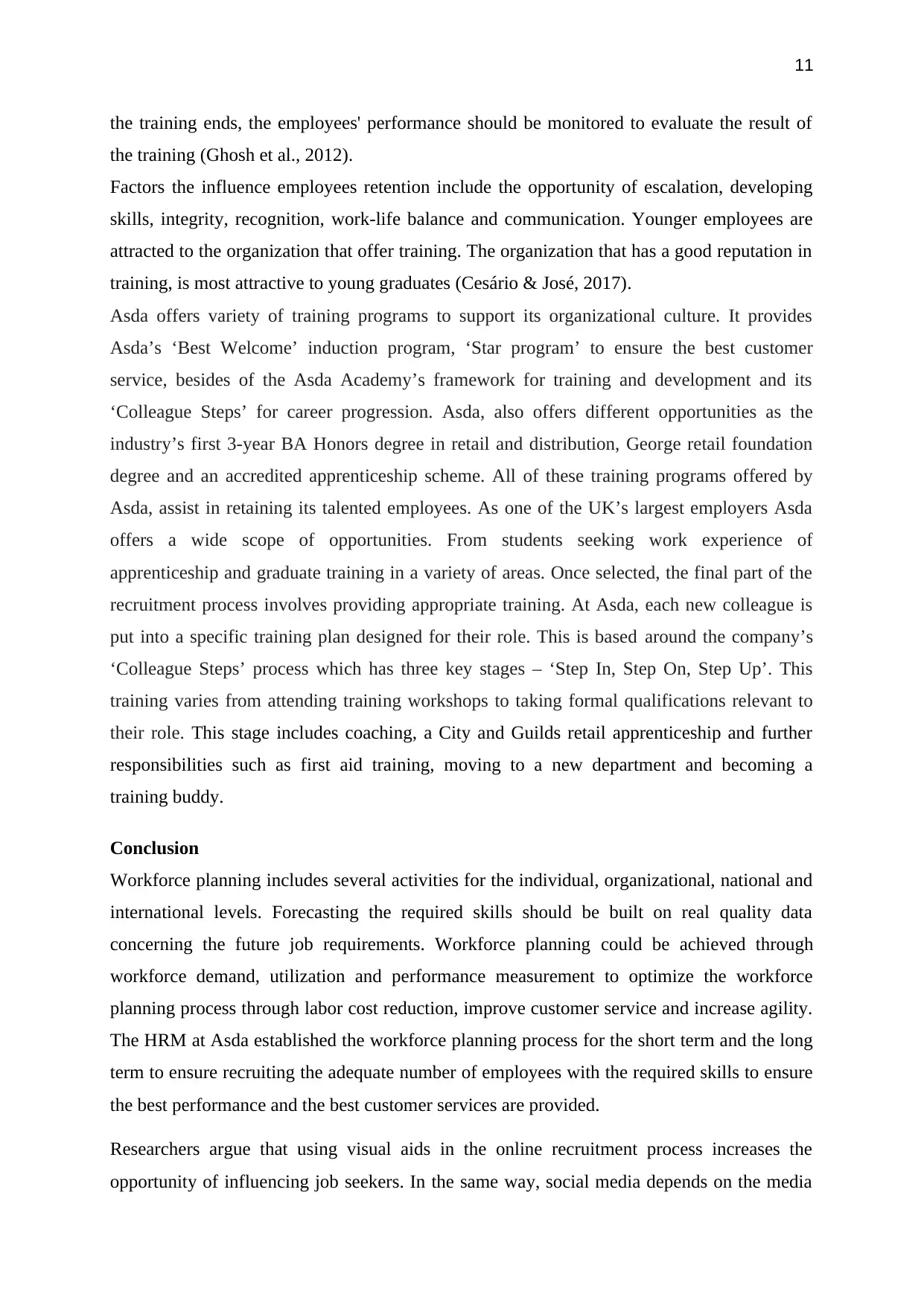
11
the training ends, the employees' performance should be monitored to evaluate the result of
the training (Ghosh et al., 2012).
Factors the influence employees retention include the opportunity of escalation, developing
skills, integrity, recognition, work-life balance and communication. Younger employees are
attracted to the organization that offer training. The organization that has a good reputation in
training, is most attractive to young graduates (Cesário & José, 2017).
Asda offers variety of training programs to support its organizational culture. It provides
Asda’s ‘Best Welcome’ induction program, ‘Star program’ to ensure the best customer
service, besides of the Asda Academy’s framework for training and development and its
‘Colleague Steps’ for career progression. Asda, also offers different opportunities as the
industry’s first 3-year BA Honors degree in retail and distribution, George retail foundation
degree and an accredited apprenticeship scheme. All of these training programs offered by
Asda, assist in retaining its talented employees. As one of the UK’s largest employers Asda
offers a wide scope of opportunities. From students seeking work experience of
apprenticeship and graduate training in a variety of areas. Once selected, the final part of the
recruitment process involves providing appropriate training. At Asda, each new colleague is
put into a specific training plan designed for their role. This is based around the company’s
‘Colleague Steps’ process which has three key stages – ‘Step In, Step On, Step Up’. This
training varies from attending training workshops to taking formal qualifications relevant to
their role. This stage includes coaching, a City and Guilds retail apprenticeship and further
responsibilities such as first aid training, moving to a new department and becoming a
training buddy.
Conclusion
Workforce planning includes several activities for the individual, organizational, national and
international levels. Forecasting the required skills should be built on real quality data
concerning the future job requirements. Workforce planning could be achieved through
workforce demand, utilization and performance measurement to optimize the workforce
planning process through labor cost reduction, improve customer service and increase agility.
The HRM at Asda established the workforce planning process for the short term and the long
term to ensure recruiting the adequate number of employees with the required skills to ensure
the best performance and the best customer services are provided.
Researchers argue that using visual aids in the online recruitment process increases the
opportunity of influencing job seekers. In the same way, social media depends on the media
the training ends, the employees' performance should be monitored to evaluate the result of
the training (Ghosh et al., 2012).
Factors the influence employees retention include the opportunity of escalation, developing
skills, integrity, recognition, work-life balance and communication. Younger employees are
attracted to the organization that offer training. The organization that has a good reputation in
training, is most attractive to young graduates (Cesário & José, 2017).
Asda offers variety of training programs to support its organizational culture. It provides
Asda’s ‘Best Welcome’ induction program, ‘Star program’ to ensure the best customer
service, besides of the Asda Academy’s framework for training and development and its
‘Colleague Steps’ for career progression. Asda, also offers different opportunities as the
industry’s first 3-year BA Honors degree in retail and distribution, George retail foundation
degree and an accredited apprenticeship scheme. All of these training programs offered by
Asda, assist in retaining its talented employees. As one of the UK’s largest employers Asda
offers a wide scope of opportunities. From students seeking work experience of
apprenticeship and graduate training in a variety of areas. Once selected, the final part of the
recruitment process involves providing appropriate training. At Asda, each new colleague is
put into a specific training plan designed for their role. This is based around the company’s
‘Colleague Steps’ process which has three key stages – ‘Step In, Step On, Step Up’. This
training varies from attending training workshops to taking formal qualifications relevant to
their role. This stage includes coaching, a City and Guilds retail apprenticeship and further
responsibilities such as first aid training, moving to a new department and becoming a
training buddy.
Conclusion
Workforce planning includes several activities for the individual, organizational, national and
international levels. Forecasting the required skills should be built on real quality data
concerning the future job requirements. Workforce planning could be achieved through
workforce demand, utilization and performance measurement to optimize the workforce
planning process through labor cost reduction, improve customer service and increase agility.
The HRM at Asda established the workforce planning process for the short term and the long
term to ensure recruiting the adequate number of employees with the required skills to ensure
the best performance and the best customer services are provided.
Researchers argue that using visual aids in the online recruitment process increases the
opportunity of influencing job seekers. In the same way, social media depends on the media
⊘ This is a preview!⊘
Do you want full access?
Subscribe today to unlock all pages.

Trusted by 1+ million students worldwide
1 out of 16
Related Documents
Your All-in-One AI-Powered Toolkit for Academic Success.
+13062052269
info@desklib.com
Available 24*7 on WhatsApp / Email
![[object Object]](/_next/static/media/star-bottom.7253800d.svg)
Unlock your academic potential
Copyright © 2020–2025 A2Z Services. All Rights Reserved. Developed and managed by ZUCOL.




